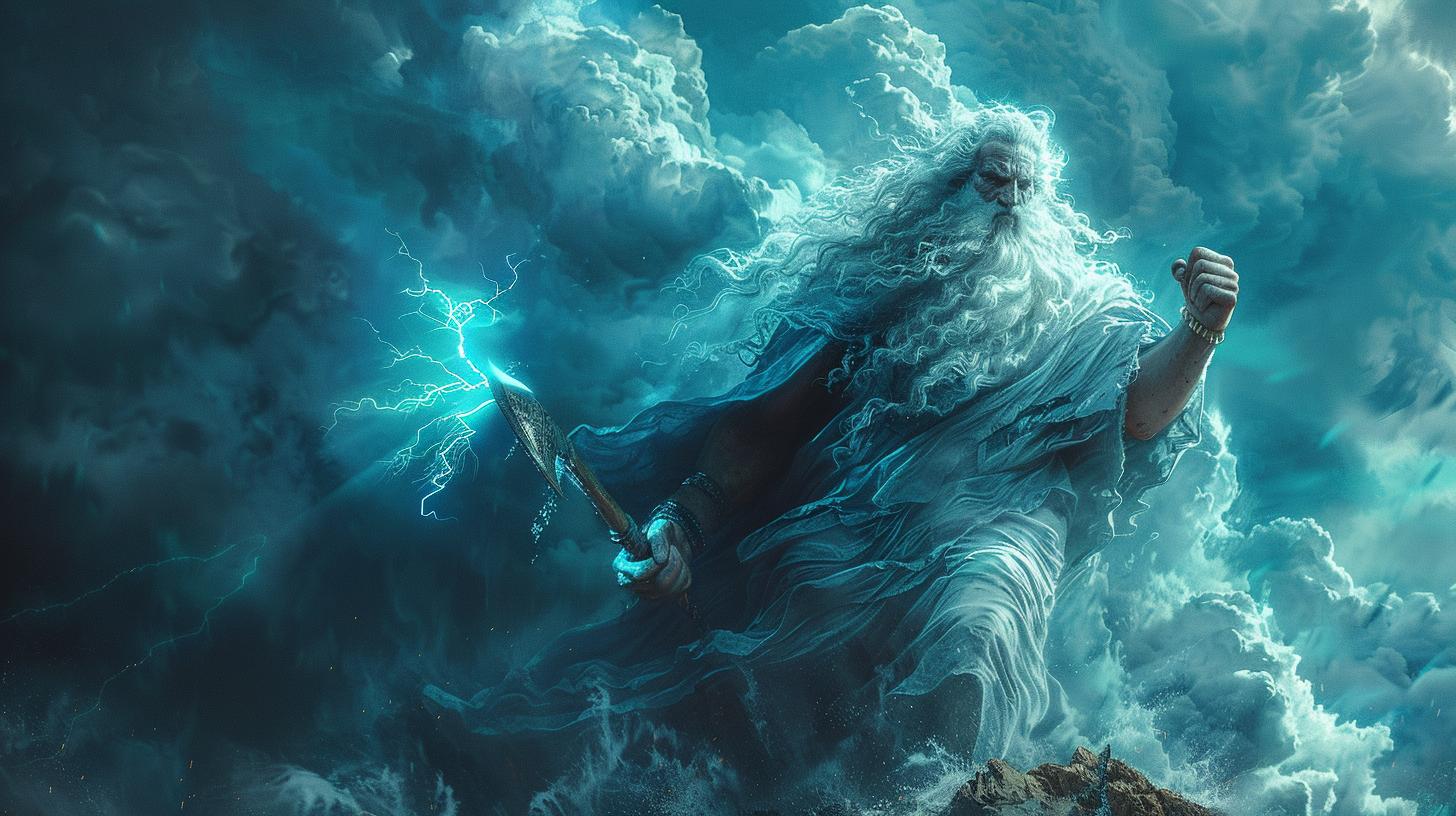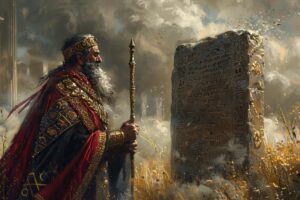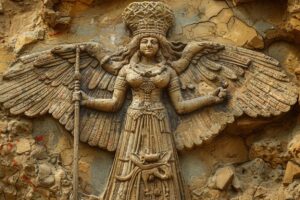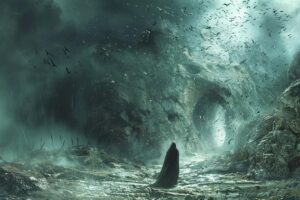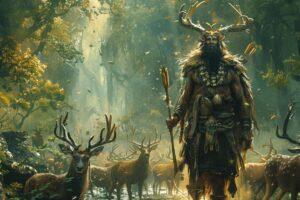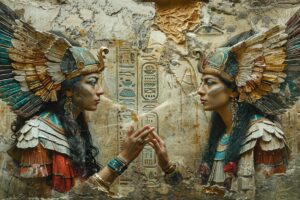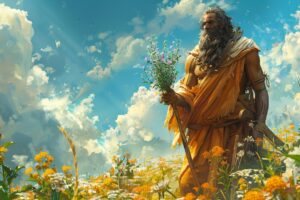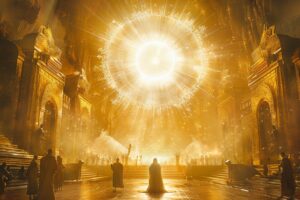Storm God Teshub: Origins, Myths, and Legacy
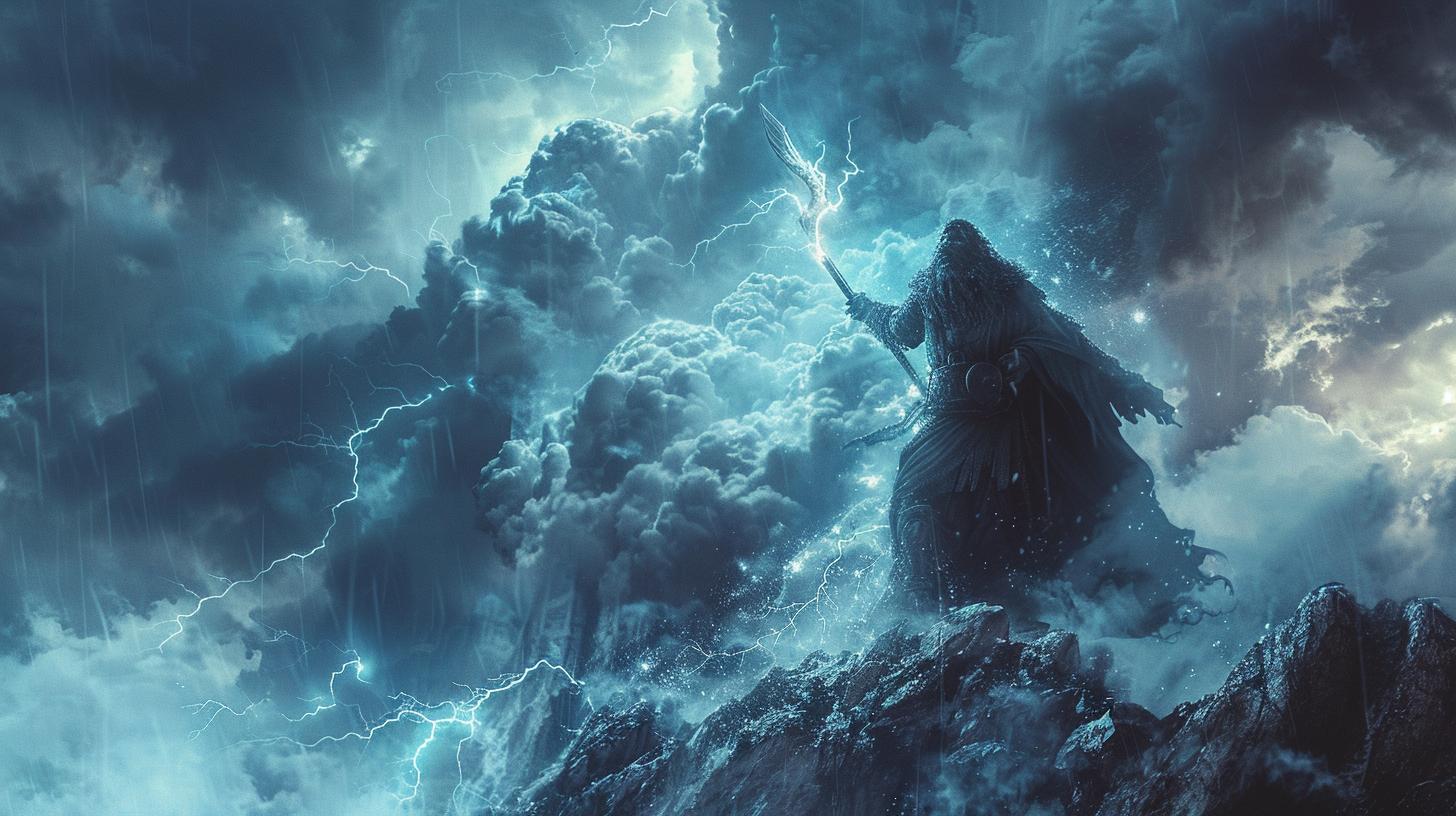
Teshub is the storm god in the Hurrian pantheon, known for his control over weather elements. His name has several variants and his influence extends into Hittite culture and other ancient Near Eastern societies.
As a weather god, Teshub wielded thunder, lightning, and rain, impacting agriculture and natural water sources. He is depicted in various artworks, often shown with lightning bolts or riding sacred bulls.
Origin and Etymology
Understanding the origin and etymology of Teshub provides insight into his significance within the Hurrian culture and beyond.
Hurrian Linguistic Roots
The name Teshub is linguistically rooted in the Hurrian language, an ancient language spoken by the Hurrians in the Near East. While the exact etymology remains uncertain, it demonstrates the cultural and religious importance attributed to this deity.
Hurrian language, distinct yet influential, shared traits with neighboring languages. This linguistic connectivity helped spread the worship and narratives surrounding Teshub.
Variants of the Name Teshub
Throughout ancient texts, Teshub’s name appears in various forms. These variations reflect the different phonetic and logographic writing systems used by the scribes of the time.
Teššub
Tešub
Teššob
Teššop
These variants show the adaptability of the name Teshub across different cultures and periods, maintaining his prominence in diverse contexts.
Role and Characteristics
Teshub, the Hurrian storm god, played a multifaceted role in the ancient Near Eastern pantheon, significantly impacting weather patterns, agriculture, and divine authority.
As a Weather God
As the god of storms, Teshub controlled the weather, including thunderstorms, rains, and winds. His influence was crucial for the agricultural societies dependent on rainfall for crop growth.
Powers and Abilities
Teshub possessed extraordinary powers over natural elements.
He could summon thunderstorms, induce heavy rains, and control violent winds, which symbolized both protection and destruction.
- Summoning thunderstorms
- Inducing heavy rainfall
- Controlling violent winds
Symbols and Weapons
His divine arsenal included symbols like lightning bolts, frequently depicted as bundles of lightning in his hands. These items represented his authority over storms and his ability to unleash natural forces.
- Lightning bolts
- Thunder
- Wind
Influence on Vegetation and Water Sources
Teshub’s control over rainfall directly affected the fertility of the land. Adequate rain meant prosperous crops and abundant water sources, making him crucial for sustaining life.
His powers ensured the growth of vegetation and the flow of rivers and springs, reflecting his importance in agrarian societies.
The balance he maintained between destructive storms and nurturing rain was vital for the region’s agricultural cycle.
Authority Over Mortals and Deities
Teshub held immense authority, not only over mortals but also over other gods. He was revered as a supreme deity capable of dictating the fate of humans and gods alike.
His dominion extended across the earth and sky, enforcing his will through natural phenomena.
Despite his overarching power, Teshub did not rule the sea or the underworld.
- Dominion over the earth and sky
- Influence on human and divine affairs
- Exclusion from ruling the sea and underworld
Iconography and Artistic Representation
Iconographic representations play a fundamental role in understanding the significance of Teshub.
His depictions reveal much about his place in the Hurrian and Hittite pantheons.
Common Depictions
Teshub is frequently depicted as a bearded figure armed with symbols of his power. He is commonly shown holding lightning bolts, indicative of his control over the storm elements. Another recurring image is Teshub riding or standing beside sacred bulls, which underscores his dominion over these powerful animals.
- Bearded figure
- Wielding lightning bolts
- Accompanied by sacred bulls
Notable Artistic Examples
Sanctuary of Yazılıkaya
The Sanctuary of Yazılıkaya offers one of the most significant artistic representations of Teshub. In this Hittite rock sanctuary, Teshub is portrayed at the forefront of a procession of male deities.
He is depicted meeting his wife, Hepat, who leads a similar procession of goddesses. This tableau emphasizes his preeminent status in the divine hierarchy.
Representation with Sacred Bulls
One iconic representation shows Teshub driving a chariot pulled by two sacred bulls named Šeri and Ḫurri. This depiction symbolizes both his strength and his mastery over nature. The bulls themselves are vital aspects of his iconography, representing the raw power and force associated with the storm god.
Imagery of Supremacy
Imagery depicting Teshub often underscores his supremacy over other deities and natural elements. Noteworthy is his portrayal standing on the necks of two mountain gods, symbolizing his absolute control over the earth and its elements.
Such representations not only highlight his dominant role but also serve to depict the awe and reverence he commanded within the pantheon.
- Driving a chariot with sacred bulls
- Standing on mountain gods
- Leading divine processions
Associated Myths and Texts
The myths surrounding Teshub present a rich and intricate narrative tapestry, reflecting his important position in Hurrian mythology.
The Cycle of Kumarbi
The Song of Emergence
The “Song of Emergence” tells the vivid story of Teshub’s peculiar birth from the skull of Kumarbi. This occurred after Kumarbi bit off Anu’s genitals during their struggle for cosmic supremacy.
This myth highlights the violent and complex nature of divine ascendancy in Hurrian mythology.
The Song of LAMMA
The “Song of LAMMA” features the heroic deeds of Teshub in his journey towards becoming the supreme deity. It describes various trials and confrontations with divine adversaries, reflecting his strengths and divine right to rule.
The Song of Hedammu
The “Song of Hedammu” narrates Teshub’s battle against the sea-monster Hedammu, a formidable antagonist born from the sea-goddess Šauška and Kumarbi. This myth emphasizes Teshub’s role as a protector against chaotic forces.
The Song of Ullikummi
In the “Song of Ullikummi,” Teshub confronts Ullikummi, a stone giant created by Kumarbi to dethrone him. Ullikummi grows rapidly and threatens the cosmos, but Teshub, with the help of his divine allies, manages to overcome this immense threat.
Other Hurrian Myths
The Song of Liberation
The “Song of Liberation” details Teshub’s efforts to free the population of Igingalliš from the oppressive rule of Ebla. His interactions with the goddess Ishara and the queen of the underworld, Allani, are key components of this narrative, showcasing his diplomatic and martial prowess.
Appearances in Heroic Narratives
Tale of Appu
In the “Tale of Appu,” Teshub plays a pivotal role in guiding the farmer Appu. This story blends divine intervention with human endeavors and underscores Teshub’s influence over mortal affairs.
Hurrian Epic of Gilgamesh
The Hurrian adaptation of the “Epic of Gilgamesh” includes Teshub as an influential figure.
His presence in this narrative reiterates his importance and connects Hurrian myths with wider Mesopotamian epic traditions.
Familial Relations and Divine Court
The familial relations and divine court of Teshub feature prominently in Hurrian mythology, highlighting his interactions with other deities.
Spouse Hepat
Teshub was married to Hepat, a goddess initially worshipped in Aleppo before being integrated into the Hurrian pantheon. Hepat plays a significant role alongside Teshub, often depicted together in artistic representations and religious texts.
She is frequently shown leading a procession of goddesses, symbolizing her esteemed position among divine beings.
Offspring
Teshub’s family includes several notable offspring, each playing unique roles within the mythological narratives.
Šarruma
Šarruma, known for his association with mountains, represents strength and is often depicted alongside his father. In iconography, he sometimes appears riding a panther, symbolizing his power and command over nature.
Allanzu
Allanzu, another of Teshub’s children, is less frequently mentioned but still holds importance within the divine court. She contributes to the familial prestige and extends Teshub’s influence through her own deeds and associations.
Kunzišalli
Kunzišalli is another offspring linked to Teshub. Evidence of Kunzišalli’s role is sparse, yet their inclusion in the divine family underscores the extensive nature of Teshub’s lineage.
Court Deities
The divine court of Teshub includes several key deities who assist and accompany him in various capacities. These members are frequently listed in detailed offering records known as ‘kaluti.’
Tenu
Tenu is one of Teshub’s court deities, often associated with protective roles.
His presence in the court signifies the layered structure of divine authority in Hurrian religion.
Pentikalli
Pentikalli also serves in Teshub’s divine entourage. The specifics of his duties are not completely clear but emphasize his integral role within the divine framework.
Šeri and Ḫurri
Šeri and Ḫurri are the sacred bulls often depicted pulling Teshub’s chariot. These bulls symbolize power and stability, crucial attributes supporting Teshub’s role as a weather god.
Mountain Gods Namni and Ḫazzi
Namni and Ḫazzi are mountain gods depicted under Teshub’s feet in various artistic representations.
This imagery underscores Teshub’s dominance and control over the natural world.
Cultural Equivalents and Syncretism
Teshub’s influence extended beyond the Hurrian pantheon, finding parallels and equivalents in various ancient Near Eastern cultures.
Mesopotamian and Syrian Parallels
In Mesopotamian and Syrian mythology, Teshub’s characteristics and attributes can be seen in deities that played similar roles.
Adad
Adad, also known as Hadad, was a prominent storm god in Mesopotamian religion. Like Teshub, Adad controlled weather elements such as thunderstorms and rainfall. Adad’s domain included not only the skies but also fertility and agriculture, similar to Teshub’s influence on vegetation and water sources.
Baal Ugarit
Baal, particularly in the Ugaritic texts, shares many attributes with Teshub. Known as the god of storms and rain, Baal was revered for his power over the weather and the fertility of the land.
Baal’s mythology also features battles and struggles for supremacy, echoing Teshub’s confrontations in the Hurrian myths.
Anatolian Equivalents
In Anatolia, Teshub’s characteristics were mirrored in local deities, reflecting his widespread influence and syncretism across regions.
Tarḫunna of the Hittites
Tarḫunna was the Hittite storm god and principal deity, occupying a position similar to Teshub’s in the Hurrian pantheon. Tarḫunna wielded control over the weather, particularly thunderstorms, and was deeply integrated into Hittite state rituals and mythology.
The syncretism between Teshub and Tarḫunna highlights the cultural exchange between the Hurrians and Hittites.
Tarḫunz of the Luwians
Tarḫunz, the Luwian counterpart, also personified storm and weather phenomena. Comparable to Teshub and Tarḫunna, Tarḫunz was depicted as a powerful deity controlling rain and fertility. The Luwians, like their Hittite neighbors, incorporated aspects of Teshub’s mythology, showcasing the deep cultural and religious syncretism in ancient Anatolia.
Centers of Worship and Cult Practices
The worship of Teshub, the storm god, was prevalent in various regions of the ancient Near East, with several key centers dedicated to his cult and rituals.
Early Evidence and Locations
The earliest evidence of Teshub’s worship dates back to the Ur III period. This includes Hurrian theophoric names and a royal inscription from Urkesh. These findings suggest that the cult of Teshub was already significant during this time.
Main Centers of Worship
Kumme and Arrapha
Kumme and Arrapha were among the primary centers of Teshub’s worship. Kumme, situated in the region of modern-day northern Iraq, served as a major religious hub. Arrapha, near present-day Kirkuk, was also a significant site, marking a central point of Hurrian religious activities.
The Role in Mitanni and Kizzuwatna
In the Mitanni kingdom, the city of Kaḫat in northern Syria was closely associated with Teshub. In Kizzuwatna, located in southeastern Turkey, the primary site for his worship was Kummanni.
These regions played crucial roles in the dispersion of Teshub’s cult.
Popularity in Ugarit
In Ugarit, the integration of Hurrian and local elements in religious practices was evident. Teshub’s worship was notably intertwined with local deities, reflecting a profound cultural and religious exchange. This syncretism is well-documented in Ugaritic texts, showcasing Teshub’s widespread veneration.
Influence and Legacy
Teshub’s legacy extends beyond Hurrian culture, influencing various neighboring cultures and appearing in numerous texts and artworks.
Integration into Other Cultures
Teshub was not confined to the Hurrian pantheon. His character and attributes were integrated into other cultures, demonstrating his expansive influence in the ancient Near East.
In Mesopotamia, he was associated with the storm god Adad. In Syria, he was linked to Baal of Ugarit, both deities sharing similar characteristics.
This cultural integration underscores the widespread recognition and reverence for Teshub.
His influence also reached Anatolia, where he was identified with the Hittite storm god Tarḫunna and the Luwian god Tarḫunz.
These assimilations reflect Teshub’s significant role in the religious landscape of multiple ancient civilizations.
Representation in Texts and Myths
Influence in Hittite Texts
Hittite texts extensively document Teshub, often depicting him as a central figure in their pantheon. His myths were translated and adapted, maintaining his prominence. The ‘Cycle of Kumarbi’ is a notable example, where Teshub’s struggles and triumphs are vividly described, illustrating his importance in Hittite religion.
Depictions in Near Eastern Art
Teshub was a popular subject in ancient Near Eastern art. He is frequently portrayed wielding lightning bolts, symbolizing his control over storms. Artistic representations often show him standing on mountains, signifying his supremacy and divine authority.
The sanctuary of Yazılıkaya provides significant examples of his iconography, including depictions with sacred bulls emphasizing his strength and power.
Modern Interpretations and Studies
Modern scholars have continued to explore Teshub’s influence and legacy, bringing new interpretations and insights into his character and role. Contemporary studies focus on his integration into various cultures, examining how his worship evolved and adapted over time.
These studies often highlight the syncretism evident in Teshub’s worship, reflecting broader cultural interactions across the ancient Near East.
Recent archaeological findings and textual analysis provide a deeper understanding of his influence, revealing connections between Teshub and other deities across different regions.
These modern interpretations underscore his enduring legacy and significance in ancient mythology.












